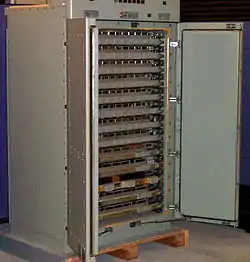AN/USQ-20
The AN/USQ-20, or CP-642[1][2][3] or Naval Tactical Data System (NTDS), was designed as a more reliable replacement for the Seymour Cray-designed AN/USQ-17 with the same instruction set. The first batch of 17 computers were delivered to the Navy starting in early 1961.[4]

A version of the AN/USQ-20 for use by the other military services and NASA was designated the UNIVAC 1206. Another version, designated the G-40, replaced the vacuum tube UNIVAC 1104 in the BOMARC Missile Program.
Technical
The machine was the size and shape of an old-fashioned double-door refrigerator, about six feet tall (roughly 1.80 meters).
Instructions were represented as 30-bit words in the following format:
f 6 bits function code j 3 bits jump condition designator k 3 bits partial word designator b 3 bits which index register to use y 15 bits operand address in memory
Numbers were represented as 30-bit words. This allowed for five 6-bit alphanumeric characters per word.
The main memory was 32,768 words of core memory.
The available processor registers were:
- One 30-bit arithmetic (A) register.
- A contiguous 30-bit Q register (total of 60 bits for the result of multiplication or the dividend in division).
- Seven 15-bit index (B) registers (note: register B0 is always zero).
References
- David L. Boslaugh. "IEEE Global History Network - First-Hand:Testing the Naval Tactical Data System - Chapter 5 of the Story of the Naval Tactical Data System". Retrieved March 11, 2021.
- "Computer History Museum:Managing the Threat". Retrieved March 11, 2021.
- "UNIVAC-NTDS historical notes". Retrieved March 11, 2021.
- David L. Boslaugh. "IEEE Global History Network - First-Hand:Moving the Firing Key to NTDS - Chapter 6 of the Story of the Naval Tactical Data System". Retrieved March 11, 2021.
External links
- UNIVAC-NTDS: UNIVAC 1206, AN/USQ-20 – From the Antique Computer website